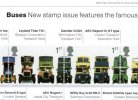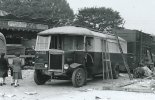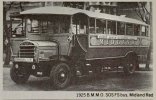-
Welcome to this forum . We are a worldwide group with a common interest in Birmingham and its history. While here, please follow a few simple rules. We ask that you respect other members, thank those who have helped you and please keep your contributions on-topic with the thread.
We do hope you enjoy your visit. BHF Admin Team
You are using an out of date browser. It may not display this or other websites correctly.
You should upgrade or use an alternative browser.
You should upgrade or use an alternative browser.
Birmingham buses
- Thread starter ragga
- Start date
Richard Dye
master brummie
On a few cold rainy days during school holidays, with know one to play with (I was about 12 ish) I would walk to Hockley from Handsworth get on the #11 bus go upstairs to the front and go around the outer circle and watch people and places. When we go back to Hockley, I got off and walked home. A good way to spend an afternoon!
Covroad
master brummie
To true , a real view of BrumHi,
In my teens I walked the Outer Circle route on two occasions, and there were certainly
stark differences between the districts it goes through.
Kind regards
Dave
Radiorails
master brummie
Eric Gibson
master brummie
As a lad I got on the No11 and said I wanted 'to go all round'. The conductress glared at me and shouted "You mean an excursion ticket." 
Bob Davis
Bob Davis
Thanks for that, gosh what a change over the years. I hardly recognised any of it.To true , a real view of Brum
try this link on YouTube it is an update bus no 8 bus journey
Bob
Eric Gibson
master brummie
Well that was interesting, a few places I recognised, not much green in Bordesley Green  I'd have to question the viability of that particular run, I'm sure the passengers appreciated it but I tried to count them, on the whole trip about 18, mostly seemingly for just a couple of stops. Sunday maybe?
I'd have to question the viability of that particular run, I'm sure the passengers appreciated it but I tried to count them, on the whole trip about 18, mostly seemingly for just a couple of stops. Sunday maybe?
Lloyd
master brummie
When the City Transport was about to "One Man" the Inner Circle, the union objected saying that passengers would pay an incorrect (lower) fare for their journey required. The management replied that they didn't really care, as everyone would pay something whereas Conductors did not have time to go round for all the fares at present, and some passengers were getting away with free rides. In those days housing and industry was far more concentrated, and most workers used the bus for commuting, so I'm not surprised the buses are nearly empty now.
Last edited:
Me, too. I lived in Ash Road, when I was little, lying in bed at bedtime, and used to listen to the buses struggling up the hill, changing gears as it got to our house.The 8 inner circle , I spent hours on that route both going to work , and just going out.
This is at the bottom of Ash Road, turning on to Adderley Road. That shop you can see, used to be the barbers, then the post office, then my Aunty Gwen and Uncle Arthur's house (hidden by the bus)Quite a difference to the Inner Circle 8 that i knew. Most roads were just two-way with few islands (if any) and the main features used by a very busy route with double deckers.View attachment 180330
Rod Liddiard
All Systems Go.
I cycled the outer circle a few times as a boy. Inner circle never, though I lived very close to it. I used the Number 8 loads of times in the 50's. I viewed the Video of the No8 route on Youtube. Small Heath looked the most run down of all the districts rubbish/potholes illegally parked cars everywhere making the drivers job more difficult. Driver of the bus doing a great job. Where I live now I haven't seen a bus for years.Hi,
In my teens I walked the Outer Circle route on two occasions, and there were certainly
stark differences between the districts it goes through.
Kind regards
Dave
Pedrocut
Master Barmmie
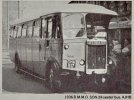
The Birmingham & Midland Motor Omnibus Co. Ltd, Edgbaston, Birmingham.
“This company, best known as "Midland Red", had been in business as a bus operator for nineteen years before it commenced the design
and manufacture of its own vehicles in 1923. This move was inspired by the need for a fast, light pneumatic-tired bus capable of competing with
the inexpensive American-built vehicles used by B.M.M.O.'s competitors. No such vehicle was then available on the home market so the company decided to fill the gap by building buses to serve its own needs and also for sale to other companies in the British Automobile Traction group. Group members to whom vehicles were supplied had their names cast prominently into the radiator shell, giving the appearance that they were the manufacturer…”
The Complete encyclopedia of commercial vehicles. Publication date 1979
mikeflan
master brummie
And when they'd had their life....the Fairground and Circus folk loved them to live in.......always great to see them in their retirement ...if one could call it thatView attachment 181630
The Birmingham & Midland Motor Omnibus Co. Ltd, Edgbaston, Birmingham.
“This company, best known as "Midland Red", had been in business as a bus operator for nineteen years before it commenced the design
and manufacture of its own vehicles in 1923. This move was inspired by the need for a fast, light pneumatic-tired bus capable of competing with
the inexpensive American-built vehicles used by B.M.M.O.'s competitors. No such vehicle was then available on the home market so the company decided to fill the gap by building buses to serve its own needs and also for sale to other companies in the British Automobile Traction group. Group members to whom vehicles were supplied had their names cast prominently into the radiator shell, giving the appearance that they were the manufacturer…”
The Complete encyclopedia of commercial vehicles. Publication date 1979
Lloyd
master brummie
Brummie a long time ago
master brummie
When we were managing caravan sites several years ago now, a bus similar to the above turned up to stay for a few days. I think it may have been a bit 'newer' than the photos above, and Julie recognised it as similar to the one she went to school in as a little girl early 50s. This one was immaculately restored on the outside, and ran very sweetly. It was maroon and cream, which the owner said were close to the original colours. The inside had been very well converted into a motor home, using materials appropriate to the vehicle age.
It was very much a 'marmite' outfit. We had people coming in to comment how well it had been done, and others complaining that it shouldn't be allowed on site as it degraded the appearance of the site with all the modern caravans. (Rank has its privileges, it stayed).
Andrew.
Pedrocut
Master Barmmie
ANGLO-FRENCH (GB) 1896-1897
Anglo-French Motor Carriage Co., Digbeth, Birmingham Anglo-French vehicles were built both in private and commercial guise in about equal numbers. Initially production consisted mainly of modified Benz and Roger-Benz types with driving belts and chains eliminated in favor of a friction disc transmission designed by the Chief Engineer, Lieutenant Day. Bodywork was, however, of all-British construction and was assembled in the Birmingham works. Small charabancs, brewer's drays and delivery vans were produced utilizing horizontal engines of 8 and 10 hp, the former being twin cylindered, but later models employed belt drive from the engine to a geared countershaft and thence, centrally, by chain to the back axle. The company enjoyed a short and chequered career, during which the activities of its French directors were often both questionable and questioned on ethical grounds. This did not prevent firms like Sunlight Soap from buying and operating their vehicles. MJ WW
Anglo-French Motor Carriage Co., Digbeth, Birmingham Anglo-French vehicles were built both in private and commercial guise in about equal numbers. Initially production consisted mainly of modified Benz and Roger-Benz types with driving belts and chains eliminated in favor of a friction disc transmission designed by the Chief Engineer, Lieutenant Day. Bodywork was, however, of all-British construction and was assembled in the Birmingham works. Small charabancs, brewer's drays and delivery vans were produced utilizing horizontal engines of 8 and 10 hp, the former being twin cylindered, but later models employed belt drive from the engine to a geared countershaft and thence, centrally, by chain to the back axle. The company enjoyed a short and chequered career, during which the activities of its French directors were often both questionable and questioned on ethical grounds. This did not prevent firms like Sunlight Soap from buying and operating their vehicles. MJ WW
Pedrocut
Master Barmmie

“A Titan TD6c built for Birmingham Corporation. This rear view of the standard Leyland metal framed body shows the straight staircase specified by Birmingham which caused a modified wheelbase. Seating was for fifty-two, four fewer than on a standard 'Hybridge’ body. Note the sweep of the rear mudguards, a feature introduced with this model.”
A history of the Leyland bus, Phillips, A. R., author (2015)
Radiorails
master brummie
This appears to be an SOS FS (forward steering) type. They has modifications and were all withdrawn in 1935.Don‘t have the details of this one…
View attachment 181688
The Complete encyclopedia of commercial vehicles, (1979)
Lloyd might give further details.
Banjo
master brummie
Adderley Road junction today.Quite a difference to the Inner Circle 8 that i knew. Most roads were just two-way with few islands (if any) and the main features used by a very busy route with double deckers.View attachment 180330

Radiorails
master brummie
These buses COX 964 - 968 (964 - 968) new in 1936 (the bus shewn) and the other five 1937 and withdrawn 1948. My records show that these were TD4c types, the TD6c EOG registered 211 - 295 came later in 1938/9.View attachment 181692
“A Titan TD6c built for Birmingham Corporation. This rear view of the standard Leyland metal framed body shows the straight staircase specified by Birmingham which caused a modified wheelbase. Seating was for fifty-two, four fewer than on a standard 'Hybridge’ body. Note the sweep of the rear mudguards, a feature introduced with this model.”
A history of the Leyland bus, Phillips, A. R., author (2015)
DavidGrain
master brummie
Midland Red was part of BET British Electrical Traction not British Automobile Traction.
HA2500 was a one off prototype . It was rebuilt from an SOS Standard at Midland Red's Carlyle Works in Edgbaston with a forward half-cab.Don‘t have the details of this one…
View attachment 181688
The Complete encyclopedia of commercial vehicles, (1979)
Pedrocut
Master Barmmie
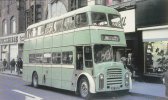
“Following the PD2s there was a natural progression to higher capacity 72-seat Northern Counties bodied Leyland PD3s in 1968 as demand for the through route to and from Cannock and Birmingham increased. A pair of manual gearbox PD3A/1s (Nos.24 and 26) appeared in March 1968, followed by a semi-automatic PD3A/5 (No.23) in May of the same year. This was notable in being the last PD3 delivered to an independent operator and all the more interesting for having a traditional rear entrance. This is my only view taken at the original Union Street terminus in Birmingham) which would soon be pedestrianised. These buses did not have spy-holes for the driver to see the destination blind as he wound it round, relying on a third party to assist. The news-vendor out of sight just ahead of the bus terminus gained a good working knowledge of the timetable and by the time the conductor got to the front of the bus the blind would be perfectly set, courtesy of the Evening Mail! No.24 (LRF 992F) waits for the 15.37 departure on a Saturday in August 1971.”
Richard Dye
master brummie
Regarding the gearbox, was the semi-automatic similar to the preselector gear box? And did any buses ever have fully automatic gear boxes?View attachment 181731
“Following the PD2s there was a natural progression to higher capacity 72-seat Northern Counties bodied Leyland PD3s in 1968 as demand for the through route to and from Cannock and Birmingham increased. A pair of manual gearbox PD3A/1s (Nos.24 and 26) appeared in March 1968, followed by a semi-automatic PD3A/5 (No.23) in May of the same year. This was notable in being the last PD3 delivered to an independent operator and all the more interesting for having a traditional rear entrance. This is my only view taken at the original Union Street terminus in Birmingham) which would soon be pedestrianised. These buses did not have spy-holes for the driver to see the destination blind as he wound it round, relying on a third party to assist. The news-vendor out of sight just ahead of the bus terminus gained a good working knowledge of the timetable and by the time the conductor got to the front of the bus the blind would be perfectly set, courtesy of the Evening Mail! No.24 (LRF 992F) waits for the 15.37 departure on a Saturday in August 1971.”
Thank you!
DavidGrain
master brummie
I don't know what a semi-automatic gearbox is. The preselector gearbox, the driver selects the next gear and then to change gear presses the leftmost of the three pedals (I can't call it a clutch but I have forgotten what it is called). I have driven a modern bus with a fully automatic gearbox.Regarding the gearbox, was the semi-automatic similar to the preselector gear box? And did any buses ever have fully automatic gear boxes?
Thank you!
Richard Dye
master brummie
Thank you David, that is what I thought the semi automatic gear box might be, the pre selector. I don’t remember the name of the left most pedal either.I don't know what a semi-automatic gearbox is. The preselector gearbox, the driver selects the next gear and then to change gear presses the leftmost of the three pedals (I can't call it a clutch but I have forgotten what it is called). I have driven a modern bus with a fully automatic gearbox.
Brummie a long time ago
master brummie
I know it is really mundane, but Wikipedia calls it the 'gear change pedal'. I hoped it would be accelerator, brake and shifter.I don’t remember the name of the left most pedal either.
Andrew.


